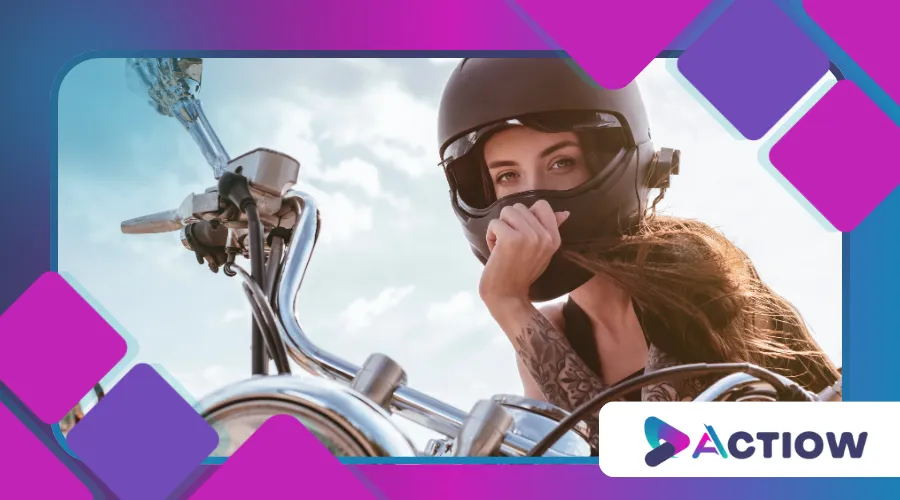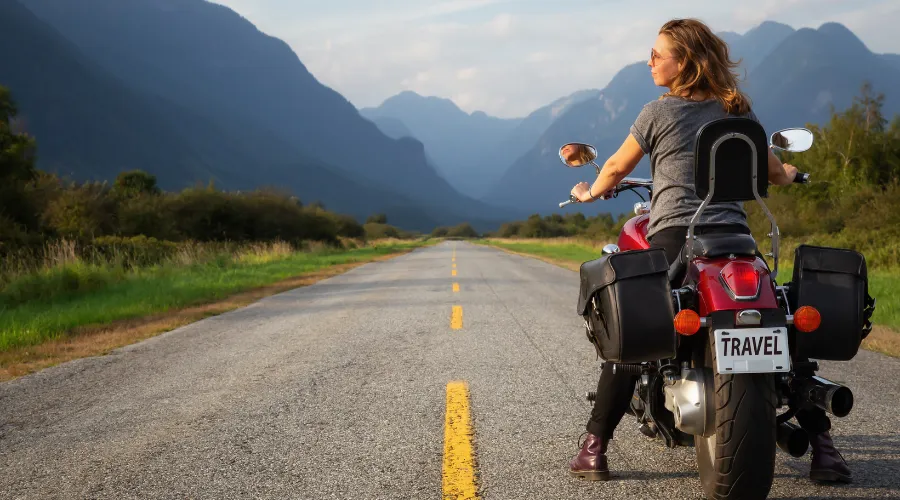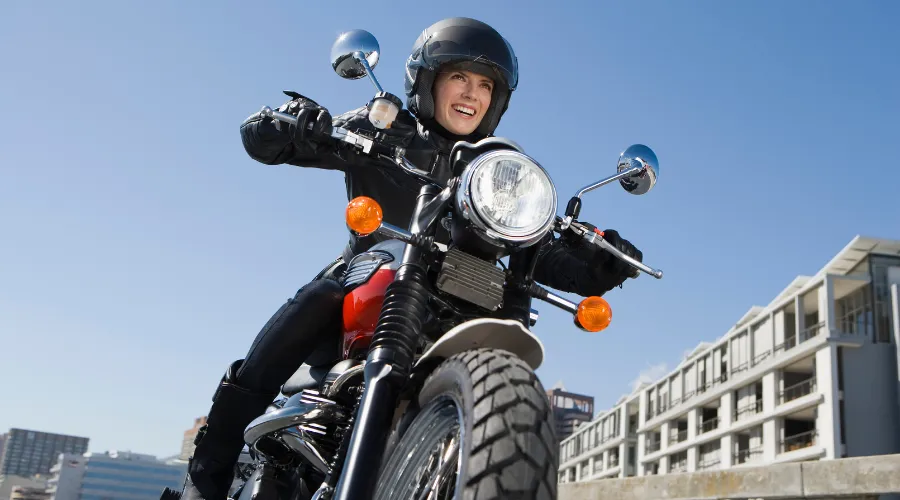Women in Motorcycling: Breaking Stereotypes

Anúncios
Women in motorcycling are rewriting the narrative of a historically male-dominated domain, challenging stereotypes with every twist of the throttle.
The open road, once seen as a rugged frontier for men, is now a canvas where women paint stories of empowerment, skill, and defiance.
From professional racers to weekend riders, female motorcyclists are not just participating—they’re reshaping perceptions, proving that passion for two wheels knows no gender.
Anúncios
This article explores how women are carving their place in motorcycling, dismantling outdated norms, and inspiring a new generation, all while navigating cultural, social, and industry challenges with grit and grace.
A Legacy of Trailblazers
The history of women in motorcycling stretches back further than many realize.
In the early 20th century, pioneers like the Van Buren sisters rode cross-country on Indian motorcycles, defying societal expectations of women’s roles.
Fast-forward to today, names like Ana Carrasco, the first woman to win a world championship in solo motorcycle racing (2018 Supersport 300), and Jenny Tinmouth, a British superbike racer, echo that legacy.
These women didn’t just ride; they competed, set records, and forced the industry to take notice.
Their achievements are not anomalies but milestones in a growing movement.
Why does this matter?
Because representation shapes perception.
When young women see riders like Carrasco or Tinmouth, they don’t just see a racer—they see possibility.
The ripple effect is tangible: more women are joining riding clubs, competing in amateur races, and embracing motorcycling as a lifestyle.
Yet, stereotypes persist, often portraying women as passengers or novices.
These outdated views clash with reality, where women are mechanics, stunt riders, and instructors, proving expertise isn’t tied to gender.
Moreover, the rise of social media has allowed these trailblazers to share their stories and connect with a broader audience.
Platforms like Instagram and YouTube showcase female riders, inspiring others to take the leap into motorcycling.
As these narratives gain visibility, they further challenge the stereotypes that have long dominated the motorcycling culture.
Cultural Shifts and Social Barriers
Motorcycling culture has long been steeped in hyper-masculine imagery—think leather-clad rebels and roaring engines.
Women in motorcycling face the challenge of entering spaces where they’re often underestimated or objectified.
Dealerships might assume a woman is buying for a partner, or fellow riders may question her mechanical know-how.
These microaggressions, while subtle, reinforce the notion that women don’t belong.
But the tide is turning.
Social media platforms like Instagram and TikTok have given female riders a megaphone.
Riders like @TheLitas, a global women’s motorcycle collective, or @BikerBabeOfficial share stories of adventure, technical expertise, and community, amassing thousands of followers.
These platforms amplify voices, creating virtual sisterhoods that counter isolation.
A 2023 Motorcycle Industry Council survey revealed that women now make up 19% of U.S. motorcycle owners, a 5% increase from a decade ago.
This statistic underscores a shift: women aren’t just riding—they’re owning the experience.
Consider Sarah, a fictional 32-year-old software engineer from Colorado.
She bought her first motorcycle, a Triumph Bonneville, after years of hesitation, fearing she wouldn’t “fit in” with the local riding scene.
Through an online women’s riding group, she found mentors who taught her to wrench her bike and navigate winding mountain roads.
Sarah’s story mirrors countless others, where community dismantles doubt, proving that belonging is earned through passion, not conformity.
Additionally, organizations and events focused on women riders are increasingly gaining traction, creating safe spaces for women to connect and learn.
These initiatives not only empower individuals but also challenge the status quo of motorcycling culture.
+ How to Ride a Motorcycle in Bad Weather: A Survival Guide for Smart Riders
The Industry’s Response: Progress and Gaps
The motorcycle industry is waking up to the power of women in motorcycling.
Brands like Harley-Davidson and Indian have launched women-specific initiatives, from riding academies to apparel designed for female bodies.
Harley’s “She Rides” campaign, for instance, offers beginner courses tailored to women, acknowledging that intimidation often keeps them from starting.
These efforts are steps forward, but gaps remain.
Gear is a prime example.
Women’s motorcycle apparel is often limited, with fewer size options or styles that prioritize aesthetics over function.
A 2024 comparison of major brands shows the disparity:
| Brand | Men’s Jacket Options | Women’s Jacket Options |
|---|---|---|
| Alpinestars | 42 | 18 |
| Dainese | 38 | 15 |
| Rev’It! | 35 | 20 |

This table highlights a clear imbalance.
Fewer options mean women may settle for ill-fitting gear, compromising safety and comfort.
The industry must innovate, not just in marketing but in product development, to meet the needs of a growing demographic.
Beyond gear, representation in leadership lags.
Few women hold executive roles in major motorcycle companies, which can stifle perspectives that drive inclusive design.
Imagine a motorcycle as a novel: if only one group writes the story, the plot misses depth.
Similarly, diverse voices in boardrooms could spark innovations—like bikes with lower seat heights or ergonomic adjustments for smaller frames—that benefit all riders.
For more insights on the industry’s response to women in motorcycling, check out the Motorcycle Industry Council.
Skill and Stereotypes: Debunking Myths
One persistent myth is that women lack the physicality or technical skill for motorcycling.
This couldn’t be further from the truth.
Riding demands mental acuity, balance, and finesse, not brute strength.
Women like Kiara Santos, a fictional stunt rider from California, embody this.
Kiara, 28, performs wheelies and stoppies for film productions, mastering techniques that require precision over power.
Her journey began with a used Yamaha R3 and a determination to prove doubters wrong.
Today, she teaches clinics, showing that skill transcends gender.
Data backs this up.
A 2022 study by the Women’s Motorcycle Conference found that women riders reported higher rates of completing advanced training courses (68%) compared to men (54%).
This suggests women are not only capable but often more dedicated to honing their craft.
Yet, the stereotype of the “novice female rider” lingers, fueled by media portrayals or casual sexism at riding events.
Analogously, think of motorcycling like a symphony.
Each rider, regardless of gender, plays a unique instrument—some with bold crescendos, others with subtle notes.
The music is richer when everyone’s invited to the orchestra.
Dismissing women’s contributions is like silencing half the ensemble; the result is a poorer performance for all.
A more inclusive narrative can empower aspiring female riders to embrace their passion without fear of judgment.

Community and Connection
What makes women in motorcycling so impactful is their knack for building community.
Women’s riding groups, like Babes Ride Out or The Litas, host events that blend riding with camaraderie.
These gatherings aren’t just about logging miles; they’re about forging bonds that challenge isolation.
At a Babes Ride Out campout, you’ll see women swapping stories, teaching maintenance tips, or leading group rides through desert trails.
These spaces redefine motorcycling as inclusive, not exclusive.
Contrast this with traditional riding clubs, which can feel intimidating or cliquey.
Women’s groups prioritize accessibility, welcoming beginners and veterans alike.
The result? A surge in participation.
Below is a snapshot of growth in women’s motorcycle events:
| Event | 2018 Attendance | 2024 Attendance |
|---|---|---|
| Babes Ride Out (U.S.) | 1,200 | 2,800 |
| Women’s Moto Summit | 800 | 1,900 |
This growth reflects a hunger for spaces where women feel seen and supported.
It’s not about rejecting co-ed riding but about creating environments where women can thrive without proving themselves.
Additionally, mentorship within these communities fosters personal and professional growth, encouraging women to take on leadership roles.
As these networks expand, they continue to break down barriers and inspire future generations of female riders.
++ The Best Motorcycle Jackets for Safety and Style
The Road Ahead: Challenges and Opportunities
Despite progress, women in motorcycling face ongoing hurdles.
Safety concerns, for instance, hit differently.
Women often report harassment on the road or at events, from catcalls to dismissive attitudes.
Addressing this requires cultural shifts—male allies calling out toxic behavior and event organizers prioritizing inclusivity.
Training programs tailored to women can also build confidence, reducing the intimidation factor.
On the flip side, opportunities abound.
The rise of electric motorcycles, with their lighter frames and smoother handling, could attract more women to the sport.
Brands like Zero Motorcycles are already marketing to diverse audiences, emphasizing sustainability and ease of use.
Meanwhile, women’s influence in media—through blogs, YouTube channels, or podcasts—continues to reshape narratives, showing that motorcycling is for everyone.
What’s the cost of ignoring this momentum?
A less vibrant, less innovative industry.
Embracing women in motorcycling isn’t just about fairness; it’s about unlocking potential.
Women bring fresh perspectives, from designing ergonomic bikes to fostering inclusive communities, that elevate the entire sport.
Moreover, partnerships between brands and women-led organizations can drive initiatives that promote safety and inclusivity, ensuring a welcoming environment for all riders.
Conclusion: Rewriting the Rules
Women in motorcycling are more than a trend—they’re a force.
From shattering records on the track to building communities off it, they’re proving that stereotypes are relics of a bygone era.
The road isn’t always smooth, with cultural biases and industry gaps posing challenges, but their resilience shines through.
Every woman who rides, wrenches, or races is a testament to possibility, inspiring others to join the journey.
The question isn’t whether women belong in motorcycling—it’s how much richer the sport will be when their contributions are fully embraced.
As more women take to two wheels, they’re not just breaking stereotypes; they’re rewriting the rules of the road, one ride at a time.
By fostering an inclusive culture and supporting women in all aspects of motorcycling, we can ensure a brighter future for the industry.
The journey is just beginning, and the possibilities are endless.
